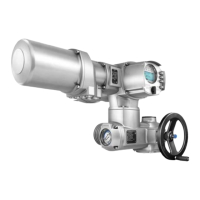7. During the complete procedure, no fault signal at collective fault signal output
contact K1?
6.2.3. Checking the collective fault signal
Configuration
This check is applicable for all safety functions.
Test procedure
Checking if collective fault signal correctly indicates the fault.
Test sequence
●
Separately check collective fault signal (K1) by simulating a fault.
- Does the output contact react to the simulated fault?
- Does the output contact react to the cancellation of the simulated fault?
●
Cancel the fault simulation after checking is complete.
6.3. Partial Valve Stroke Test (PVST)
— Option —
During the Partial Valve Stroke Test (PVST), the function of the valve is tested by
means of partial OPENING or CLOSING within a defined period of time without
interrupting the process. After successful testing, actuator controls operate the
actuator to its initial position.
PVST is used to test the function of actuator controls and actuators not operated on
a regular basis and can therefore not use reaction monitoring for diagnostics.
Diagnostic via PVST should be performed at least 10 times more often than the proof
test.
Monitoring and assessment of PVST must be ensured by the logic unit of the safety
instrumented system. For this, the collective fault signal must be assessed.
Safety function for safe end position feedback:
●
Actuator movement can be requested via any input.
●
Assessment whether the safety function signals as desired has to be performed
at the end position switches wired directly to the customer connection.
●
The actuator must be in one of the following positions:
- In one of both end positions prior to starting the test run.
The test run is performed out of the end position and back to this end po-
sition.
- At a sufficient distance from both end positions prior to starting the test
run.
The test run is performed into an end position and out of this end position.
In both cases, the travel distance must be sufficient to allow for full tripping of the
end position switch. It must be checked whether the end position switch signals the
expected position both at the beginning, during and at the end of the test.
●
Furthermore, test run monitoring must be dynamic.This means a dynamic test
whether the signal change corresponds to the expected value.
Information
If the PVST is only executed in one of both end positions, only the switch of this end
position is tested for correct function. If both end position switches (OPEN/CLOSE)
are safety relevant, a full stroke test can be performed, for example.
6.4. Maintenance
Maintenance and service tasks may only be performed by authorised personnel who
have been trained on functional safety (refer to chapter 5).
Once maintenance and service tasks have been finished, the functional test must
be completed by a validating process of the safety function including at least the
tests described in the <Safety equipment: check> and <Proof test (verification of
safe actuator function)> chapters.
In case a fault is detected during maintenance, this must be reported to AUMA Riester
GmbH & Co. KG.
14
Multi-turn actuators
Tests and maintenance SA .2 with AC(V) 01.2/AC(V)ExC 01.2

